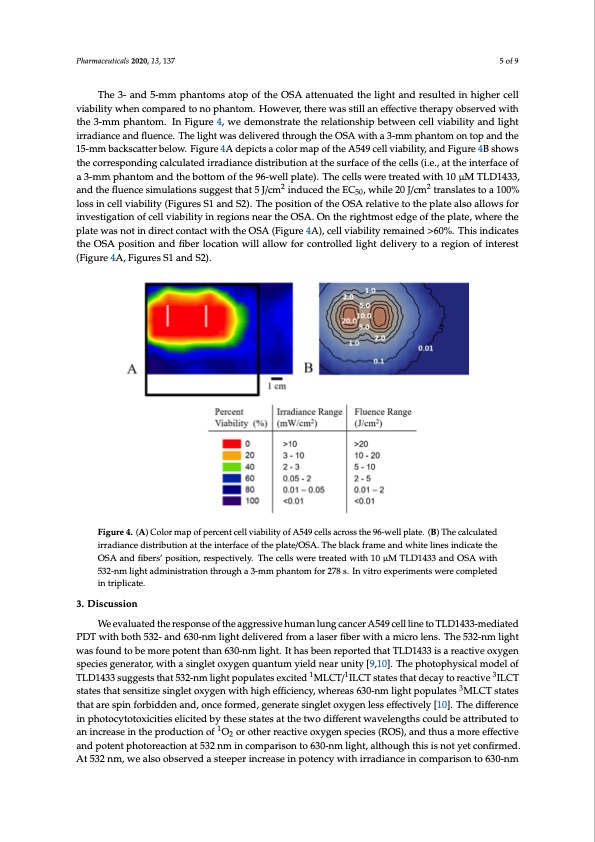
PDF Publication Title:
Text from PDF Page: 005
Pharmaceuticals 2020, 13, 137 5 of 9 The 3- and 5-mm phantoms atop of the OSA attenuated the light and resulted in higher cell viability when compared to no phantom. However, there was still an effective therapy observed with the 3-mm phantom. In Figure 4, we demonstrate the relationship between cell viability and light irradiance and fluence. The light was delivered through the OSA with a 3-mm phantom on top and the 15-mm backscatter below. Figure 4A depicts a color map of the A549 cell viability, and Figure 4B shows the corresponding calculated irradiance distribution at the surface of the cells (i.e., at the interface of a 3-mm phantom and the bottom of the 96-well plate). The cells were treated with 10 μM TLD1433, and the fluence simulations suggest that 5 J/cm2 induced the EC50, while 20 J/cm2 translates to a 100% loss in cell viability (Figures S1 and S2). The position of the OSA relative to the plate also allows for investigation of cell viability in regions near the OSA. On the rightmost edge of the plate, where the plate was not in direct contact with the OSA (Figure 4A), cell viability remained >60%. This indicates the OSA position and fiber location will allow for controlled light delivery to a region of interest (Figure 4A, Figures S1 and S2). Pharmaceuticals 2020, 13, x 5 of 9 Figure 4. (A) Color map of percent cell viability of A549 cells across the 96-well plate. (B) The Figure 4. (A) Color map of percent cell viability of A549 cells across the 96-well plate. (B) The calculated calculated irradiance distribution at the interface of the plate/OSA. The black frame and white lines irradiance distribution at the interface of the plate/OSA. The black frame and white lines indicate the indicate the OSA and fibers’ position, respectively. The cells were treated with 10 μM TLD1433 and OSA and fibers’ position, respectively. The cells were treated with 10 μM TLD1433 and OSA with OSA with 532-nm light administration through a 3-mm phantom for 278 s. In vitro experiments were 532-nm light administration through a 3-mm phantom for 278 s. In vitro experiments were completed completed in triplicate. in triplicate. 3. Discussion 3. Discussion We evaluated the response of the aggressive human lung cancer A549 cell line to TLD1433-mediated We evaluated the response of the aggressive human lung cancer A549 cell line to TLD1433- PDT with both 532- and 630-nm light delivered from a laser fiber with a micro lens. The 532-nm light mediated PDT with both 532- and 630-nm light delivered from a laser fiber with a micro lens. The was found to be more potent than 630-nm light. It has been reported that TLD1433 is a reactive oxygen 532-nm light was found to be more potent than 630-nm light. It has been reported that TLD1433 is a species generator, with a singlet oxygen quantum yield near unity [9,10]. The photophysical model of reactive oxygen species generator, with a singlet oxygen quantum yield near unity [9,10]. The TLD1433 suggests that 532-nm light populates excited 1MLCT/1ILCT states that decay to reactive 3ILCT photophysical model of TLD1433 suggests that 532-nm light populates excited 1MLCT/1ILCT states states that sensitize si3nglet oxygen with high efficiency, whereas 630-nm light populates 3MLCT states thatdecaytoreactive ILCTstatesthatsensitizesingletoxygenwithhighefficiency,whereas630-nm that are spin forbidden and, once formed, generate singlet oxygen less effectively [10]. The difference light populates 3MLCT states that are spin forbidden and, once formed, generate singlet oxygen less in photocytotoxicities elicited by these states at the two different wavelengths could be attributed to effectively [10]. The difference in photocytotoxicities elicited by these states at the two different anincreaseintheproductionof1O orotherreactiveoxygenspecies(ROS),andthusamoreeffective wavelengths could be attributed to2 an increase in the production of 1O2 or other reactive oxygen and potent photoreaction at 532 nm in comparison to 630-nm light, although this is not yet confirmed. species (ROS), and thus a more effective and potent photoreaction at 532 nm in comparison to 630- At 532 nm, we also observed a steeper increase in potency with irradiance in comparison to 630-nm nm light, although this is not yet confirmed. At 532 nm, we also observed a steeper increase in potency with irradiance in comparison to 630-nm light (Figure 2). These data suggest that 532 nm is associated with a higher production of ROS in comparison to 630-nm light, when there is sufficient oxygen in vitro. More in vivo work is needed, and underway, to assess this speculation in vivo. The 532-nm light, that was found to be potent against the A549 cells, also has a shallow (3–5 mm) tissue penetration depth and thus has the potential to inflict less collateral damage to underlying healthy tissue. We therefore suggest that this treatment is a good candidate for IO-PDT in the thoracicPDF Image | TLD1433-Mediated Photodynamic Therapy Lung Cancer Cells

PDF Search Title:
TLD1433-Mediated Photodynamic Therapy Lung Cancer CellsOriginal File Name Searched:
pharmaceuticals-13-00137-v2.pdfDIY PDF Search: Google It | Yahoo | Bing
Cruise Ship Reviews | Luxury Resort | Jet | Yacht | and Travel Tech More Info
Cruising Review Topics and Articles More Info
Software based on Filemaker for the travel industry More Info
The Burgenstock Resort: Reviews on CruisingReview website... More Info
Resort Reviews: World Class resorts... More Info
The Riffelalp Resort: Reviews on CruisingReview website... More Info
| CONTACT TEL: 608-238-6001 Email: greg@cruisingreview.com | RSS | AMP |